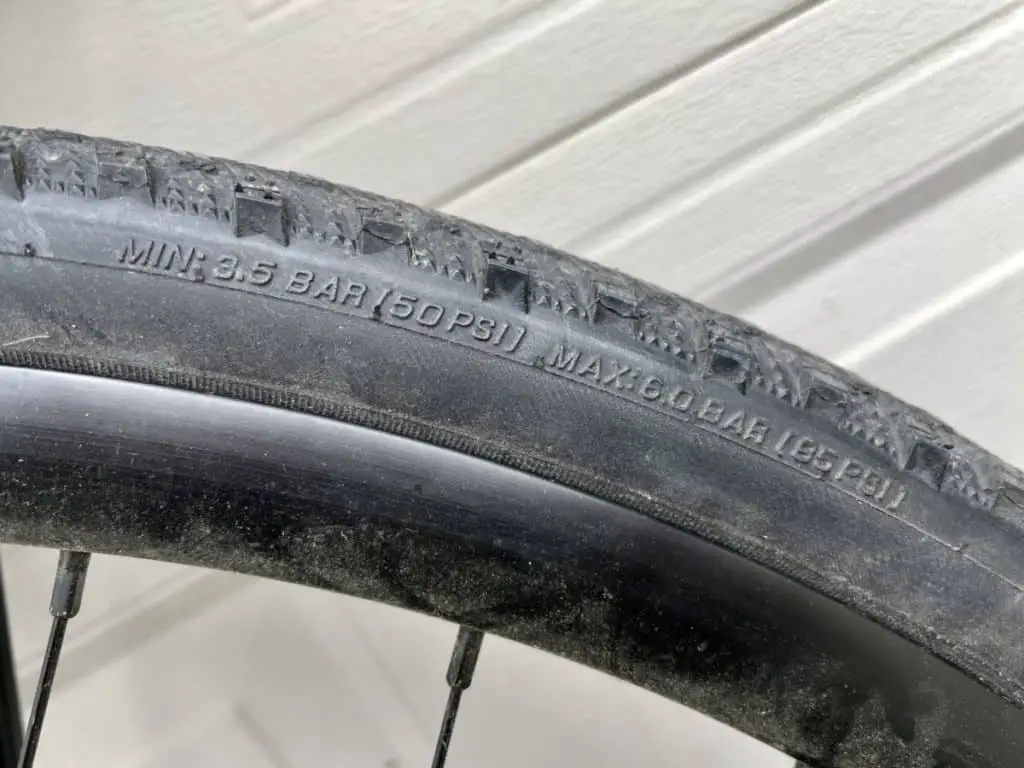To find the right air pressure for your bike tires, you have to consider tire size, type, rider weight, terrain, weather, and the style of riding you do. Luckily, tire manufacturers provide a maximum air pressure on the tire sidewall so you at least know when to stop inflating. But is there ever a reason to inflate tires to their maximum PSI?
Should Bike Tires Be Inflated to Their Maximum PSI?
Bike tires should not be inflated to their maximum PSI. A lower tire pressure provides better traction, cornering ability, comfort, and a lower risk of getting a flat. There are more reasons to go with a lower tire pressure than to go with a higher tire pressure.

When NOT to Inflate Bike Tires to Maximum PSI?
The proper tire pressure creates a balance of speed, comfort, and grip (use this tire pressure calculator to find your ideal pressure). Theoretically, a higher PSI would be faster on a very smooth surface, but that isn’t necessarily the case in real-world riding. Here are some examples of when you would want to use a lower tire pressure:
1. When the Terrain Is Rough
On rougher terrain, you’ll want to use a tire pressure on the lower end of the scale. When you have your tires pumped up too much, they’ll be very hard. This means less of the tire will come into contact with the ground as you ride. Less tire contact means you’ll have less grip.
Tires with less pressure will conform to the shape of the terrain. As a result, more of the tire will touch the ground’s surface at any given time, giving you more traction.
When the tire pressure is too high, your tires can bounce off of tiny obstacles, wasting energy that should be propelling you forward. So if the ground isn’t perfectly smooth, you’ll actually go slower than if your tire pressure was a little lower.
2. When the Ground Is Wet and Slippery
When the ground is wet, you want as much traction as possible. Lower tire pressure offers more grip when the weather conditions are less than ideal.
If your tire pressure is too high on a wet surface, you can slide and skid, especially around corners. This makes maintaining control of your bike very challenging.
3. When Riding Terrain with Many Sharp Corners
It’s easy to lose traction and skid when cornering at high speeds. A lower tire pressure will help you maintain traction around tight turns by letting your tires’ side knobs dig into the terrain better. If the terrain you plan on riding that day has a lot of sharp corners, it may be wise to reduce your tire pressure just a bit.
4. When You Want a More Comfortable Ride
A high pressure will give your tires a lot more ‘bounce.’ When you dribble a basketball completely filled with air, it will be a lot bouncier than a ball that is only half full. If your tire is filled too much, it will vibrate and bounce off any rocks, gravel, or uneven surfaces. This can be uncomfortable and contribute to fatigue.
A lower tire pressure will help absorb the shock from these bumps. Just like when you drop a basketball that has little to no air, it will absorb the force of hitting the floor rather than bouncing off.
5. When the Weather Is Extremely Hot
On long rides on a really hot day, the extra heat can expand the air in your tires even further, making blow-outs more likely. Let out a little pressure from your tires to account for heat from the sun and the road causing the air inside the tire to expand.
6. If You’re a Lighter Rider
The less you weigh, the less air pressure you need to put in your tires. A lighter rider doesn’t put the same amount of stress on their tires as a heavier rider, and won’t increase rolling resistance as much. So all things being equal (such as tires and bike weight), a lighter rider can use a lower tire pressure than a heavier rider.
7. If You Use Wider Tires
Wider tires – like mountain bike tires – hold a larger volume of air than much skinnier road tires. Because they hold more air, the pressure inside doesn’t need to be as high to achieve the same degree of tire firmness when compared to narrow tires.
For example, a road bike tire might have a PSI range of around 80 to 120 PSI, while a mountain bike tire is typically inflated to 30 PSI or less. Both tires might feel the same when you squeeze them, despite their vastly different tire pressures.
8. If You Have Tubeless Tires
If you are riding with tubeless tires, you can use an even lower tire pressure. Since there is no tube to hold the air, too much air pressure directly on the tire could cause the tire to bulge out or warp in certain places.
Should Bike Tires Ever be Inflated OVER Their Maximum PSI?
You should never inflate your tire over the max PSI. First of all, too much air in the tires will make your ride uncomfortable and negatively impact your bike handling. Second, overinflating your tires will make them wear out more quickly. Third, overinflating your tires could cause blowouts, which could lead to accidents.
If you overinflate your tire, the pressure of the air inside can cause the tire to come off the rim. Hitting some rough terrain may also cause the tire to come loose from the rim if it’s overinflated. Once the tire comes off the rim, the tube might pop and the rim could sustain damage. If your tire suddenly goes flat, you might lose control of the bike and end up in a serious accident.
